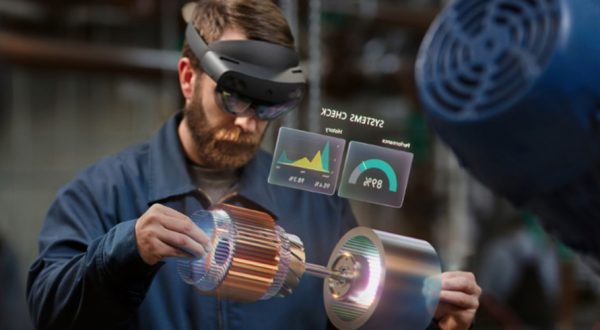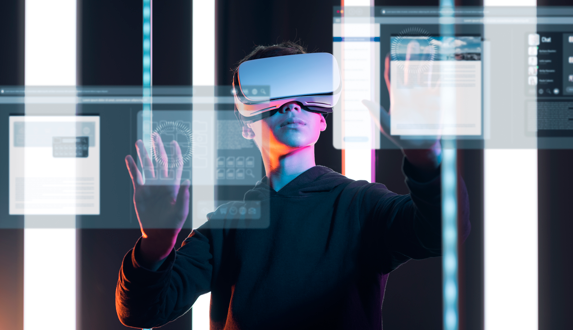Distilling different data, the AR/VR scenario is positive. The Covid-19 pandemic has accelerated the adoption of new technologies in a way we have never seen before. It has forced companies to evolve, not by choice but out of necessity. If you’re a restaurant and you weren’t on Uber Eats or Deliveroo before, now you are. If you run a traditional company where clocking in was mandatory, now you’re among the many having meetings on Zoom from anywhere. And if it was Covid-19 that made these decisions for you, it probably made wise decisions.
Immersive technologies are not immune to this driving force. Projections indicate growth in almost all sectors. A new report from Juniper Research has found that VR content alone for the consumer market will fuel a market worth $7 billion by 2025, over 160% more than the $3 billion it is expected to generate in 2020. According to Research and Markets, the revenue of the AR and VR markets is projected to reach $55.01 billion by 2021. In 2021, the AR and VR hardware segment will experience significant growth, primarily due to a 10x increase in devices. ABI Research indicates that the AR content, software, and entertainment market will see similar growth, between 90% and 100% in the period from 2021 to 2025.
5 AR/VR TRENDS IN 2021, ACCORDING TO US
In addition to the quantitatively positive trends consistently reported by analysts, we wanted to highlight some themes that will be prominent in 2021.
#1 – SPATIAL COMPUTING: THE 4TH COMPUTING REVOLUTION

This is a new branch of computer science that positions itself at the intersection of the physical and digital realms. It encompasses various rapidly evolving technologies (AI, IoT, robotics, 5G, among others), with AR/VR serving as the obvious interface of interaction. Spatial computing does everything that virtual reality and augmented reality applications do: it represents information, objects, and people in space and enables seamless interaction and coexistence between the physical and digital worlds. It achieves this through high-fidelity space mapping, the real-time interconnection between the physical and digital realms, and increasing utilization of Artificial Intelligence, which personalizes experiences and imbues physical or virtual objects with their intelligence. An application for Widiba Bank exemplifies this well: account holders can see their financial data in 3D space, interact with it using hand gestures, rotate it, and engage in conversation with an intelligent avatar. Spatial computing is, therefore, a new paradigm—an invisible and ubiquitous computing capability no longer confined within a computer or a screen but dispersed throughout space. We will interact with the virtual world in a fluid and natural manner, using physical actions such as body movements, head gestures, hand gestures, and spoken words as inputs to engage with the digital realm. In turn, the digital realm uses the physical space as a platform to interact with us through holograms, avatars, and immersive environments.
#2 – TOWARDS INCREASINGLY HYBRID MODELS

Hybrid models (a mix of physical and digital) will be the path toward the new normal in 2021. The events industry, one of the first to adapt and reinvent itself, is already experimenting with mixed formats. For example, combining in-person workshops with a limited number of participants with fully digital moments is sometimes supported by AR (e.g., Augmented Webinars) or VR (e.g., Virtual Concerts). The same applies to product showcasing processes. Due to social distancing limitations, product presentations will not only rely on stores or showrooms but will be integrated with digital stores (such as the 360° digital flagship store created for Frette). “Remote work is here to stay,” as stated in Capgemini’s latest report, “The Future of Work.” Nearly 70% of organizations with remote working experience believe that the productivity benefits of remote work are sustainable and replicable beyond the pandemic. However, this should be interpreted within a hybrid work model where physical and digital presence alternate. This creates an unequivocal demand for remote collaboration tools that counteract “Zoom fatigue” and the sense of isolation that digital work generates, improving the emotional experience of hybrid work models even before considering the user experience.
#3 – MULTIEXPERIENCE

The immersive dimension will be increasingly present, especially from a multi-experience perspective. Catalogs – and even webinars – will become “augmented.” We will discover products in AR and then verify finishes and features in-store. Traditional training can be integrated with web games that safely teach dangerous procedures through gamification (as in the recently presented case of BMW Group Italy). It can also be combined with virtual simulators that allow for the experience of dangerous procedures in a safe environment or facilitate collaboration with teams located worldwide. The phenomenon of “multi-experience,” highly promoted by Gartner, highlights this transition: from a traditional context where a computer is the only point of interaction to purchasing journeys that include multisensory and multi-touchpoint devices and interfaces, such as wearable devices and advanced computer sensors. All of this is driven by a strong logic of omnichannel. We will evaluate a motorcycle or a planetary mixer through AR glasses, schedule appointments with a dealership or a high-end kitchen store via Alexa, and there, locally, we will test drive or try out cupcakes on a simulator before making a purchase, perhaps even using bitcoin.
#4 – AVATARS WILL BE INCREASINGLY AMONG US
![]()
If the world may not yet be ready for robots with a digital brain and a mechanical body, it is certainly ready to interact with a digital brain without a body. Rapid technological advancements, such as the evolution of new AI tools, next-generation game engines, more powerful connectivity, and AR/VR software, are ready to bring a new generation of avatars into our world. You may have already heard of @lilmiquela and @noonoouri, not just avatars, but even virtual influencers. Or perhaps you have created an avatar sticker for your iPhone. By attending digital events in recent months, you may have equipped yourself with a personalized emoji face and encountered colleagues’ avatars in the digital academies’ stands. This is a clear indication of the convergence between gaming and social networks, although it has little to do with the new generation of avatars, ranging from more fantasy-like to hyper-realistic ones, such as those configurable with Replika, equipped with digital intelligence and interactive capabilities. Characters like them will guide us through virtual fairs, recommend the right product, and show us how to carry out a procedure. And what will the avatars of the future be like? Facebook tells us they will be indistinguishable from reality, interactive, intelligent, and controlled by VR devices. But we still have to wait a few years to see them in action.
#5 – XR: FROM ENTERTAINMENT TO BUSINESS APPLICATIONS

According to Deloitte, during the crisis, one-third of consumers subscribed to a video gaming service for the first time, used cloud gaming services, or watched eSports or virtual sports events. Therefore, while AR and VR continue to advance in the consumer world, the growth of virtual and augmented reality will be strongly driven by B2B applications, particularly those for prototyping and simulation. Media, gaming, telepresence, retail, medicine, and education are among the industries most likely to be involved in immersive experiences. “The risk associated with travel and meetings will drive the demand for proactive solutions that increase business efficiency and ensure employee safety,” explains Eric Abbruzzese, Director of AR/VR Research at ABI Research. Thus, the enterprise world has now entered the realm of spatial computing. Once more standardized tools, such as a “WordPress for immersive applications,” become available, these applications are likely to see much wider adoption after the initial pioneering projects.
New Year’s Resolutions for 2021
The context is clear: the convergence of different technologies, next-generation devices, AI, IoT, blockchain, voice interfaces, and robots… will open up new scenarios that are already being referred to as spatial computing. This will trigger a new demand for immersive applications where digital data and objects are visualized in space, integrated, and inseparable from the physical world, interacting with it. Therefore, modern tools that enable next-generation immersive applications will be necessary. This is our challenge for 2021 – to continue enabling immersive applications with our gaming touch, but also providing new software tools, low-code platforms, and multi-experience capabilities. We will bring the enterprise… into space.


